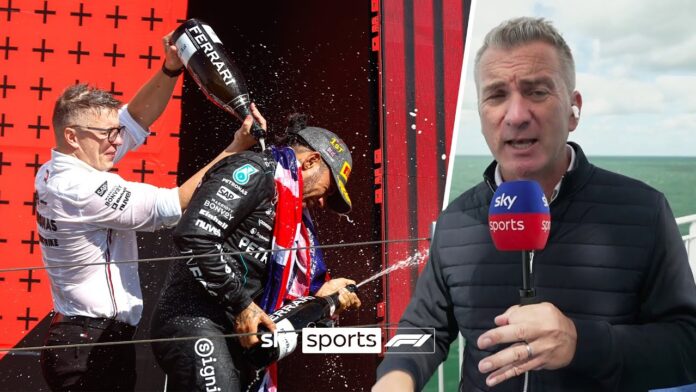Peter Bonnington, Hamilton’s race engineer for 12 years, will not join him at Ferrari, instead taking on an elevated role at Mercedes
Lewis Hamilton’s long-time race engineer, Peter Bonnington, will remain at Mercedes despite Hamilton’s upcoming move to Ferrari in 2025. Bonnington, known affectionately as ‘Bono,’ has been promoted to the head of race engineering at Mercedes, ensuring he will not accompany the seven-time Formula 1 world champion to Maranello.
Bonnington has been a pivotal figure in Hamilton’s success, having guided him through six world titles during their 12-year partnership at Mercedes. His voice, familiar to F1 fans as the one communicating with Hamilton over team radio, will continue to be heard throughout the remainder of this season as they aim for another strong finish.
Next season, Bonnington will transition to his new role while still serving as a race engineer for one of Mercedes’ drivers. George Russell, who is contracted with Mercedes until the end of 2025, is expected to remain with the team, potentially alongside Mercedes’ rising star Andrea Kimi Antonelli, who is currently competing in Formula 2.
As Hamilton moves to Ferrari, he will need to adapt to working with a new race engineer, marking a significant change in his career. However, he will encounter some familiar faces at Ferrari. Jock Clear, who was part of Hamilton’s engineering team in 2013 and 2014 and now works as a driver coach for Charles Leclerc, and Loic Serra, a former Mercedes engineer joining Ferrari as head of chassis performance engineering, will both be part of his new team.
Ferrari team principal Frederic Vasseur, who played a crucial role in Hamilton’s GP2 championship win in 2006 and his subsequent promotion to F1 is also set to provide a strong support system for Hamilton at Ferrari. Vasseur’s close relationship with Hamilton was a key factor in the driver’s decision to join the Italian team.
It remains uncertain whether Hamilton would have preferred Bonnington to join him at Ferrari, but any such move would have been prevented by a ‘non-poaching clause’ in Hamilton’s contract with Mercedes. This clause restricts Hamilton from recruiting team members when switching teams.
Hamilton and Mercedes team principal Toto Wolff are expected to address this significant shift in the team dynamics during the upcoming Dutch Grand Prix, as the F1 season resumes after the summer break.
In his new role, Bonnington will report to Mercedes’ trackside engineering director, Andrew Shovlin. Shovlin oversees all engineering activities at the racetrack, including race strategy and support. Bonnington’s focus will be on the engineering of the cars, determining the optimal aerodynamic and mechanical settings for the drivers to maximize performance.
This move aligns with the structure seen at Red Bull, where Max Verstappen’s race engineer, Gianpiero Lambiase, also serves as the head of race engineering, highlighting the importance of continuity and leadership within the engineering teams at the highest level of motorsport.
Analysis:
Political:
Bonnington’s decision to stay at Mercedes instead of joining Hamilton at Ferrari may reflect the intricate dynamics of loyalty and contract stipulations within Formula 1. The ‘non-poaching clause’ in Hamilton’s contract highlights the efforts teams take to retain critical talent and prevent the transfer of valuable knowledge and expertise to rival teams. This scenario underscores the complex political environment within the sport, where contracts and team strategies play a vital role in shaping careers and team performance.
Social:
The long-standing partnership between Hamilton and Bonnington has become one of the most recognized engineer-driver relationships in F1 history. Their collaboration has been marked by mutual respect and a deep understanding of each other’s work styles, contributing significantly to Hamilton’s success. The separation of this iconic duo will resonate with fans, marking the end of an era. It also raises questions about the adaptability of drivers like Hamilton, who must now forge a new relationship with a different engineer, which could be challenging given the deep bond he shared with Bonnington.
Racial:
As one of the few Black figures in the predominantly white world of Formula 1, Hamilton’s movements within the sport are closely watched, not just for his on-track performance but for what they signify in terms of representation and diversity. Hamilton’s success has been a beacon for diversity in motorsport, and his ability to maintain excellence amid changes, such as this transition to Ferrari, will continue to inspire discussions about race and inclusion in the sport. Bonnington’s role in supporting Hamilton’s journey has been pivotal, and their parting could also symbolize the broader challenges of diversity within the teams that make up F1.
Gender:
While the F1 world has been dominated by male figures, the strong partnership between Hamilton and Bonnington highlights the importance of collaboration and mentorship in male-dominated fields. The transition to a new engineer at Ferrari may also spotlight the broader conversation around diversity within engineering roles in motorsport. Hamilton’s move could inspire discussions on gender dynamics in F1, particularly regarding how the sport can evolve to include more women in engineering and leadership positions.
Economical:
Hamilton’s move to Ferrari, accompanied by Bonnington’s promotion at Mercedes, signals significant financial implications for both teams. Hamilton’s transfer to Ferrari is expected to come with substantial sponsorship deals and increased brand value for the Italian team. Meanwhile, Mercedes’ decision to elevate Bonnington ensures that they retain a key figure who has been instrumental in their dominance, maintaining stability and continuity in their engineering department. The financial strategy behind these decisions highlights how F1 teams must balance talent retention with the economic realities of the sport, where the right personnel decisions can have far-reaching economic impacts.
